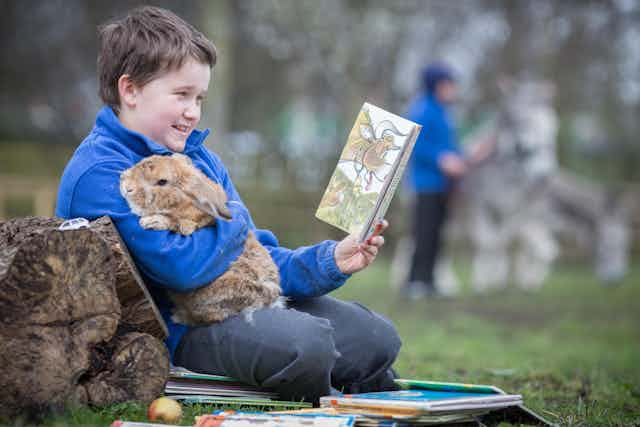Since COVID-19 hit British shores, 3.2 million pets have reportedly been purchased. Animals provide a valuable sense of companionship and a wide variety of species, including dogs, cats, fish, birds and horses have helped many people cope psychologically through the pandemic.
For educators searching for ways to help children cope, and to deal with the potential impact on their language and communication skills, animals may provide some creative solutions.

As an educator and specialist in the involvement of animals in schools, my research shows how children’s social and emotional development can benefit from interactions with animals, but also looks at how we can ensure that the wellbeing of learners and animals is considered.
Social and emotional benefits
One study we conducted involved trained dogs and their handlers doing weekly sessions in six primary schools in south Wales. Over the course of a term, pupils between the ages of five and ten, whom teachers had identified as needing help with their reading skills, spent 15 minutes at a time reading out loud to their canine companions, and reported improved self-confidence. This correlates with wider research into how reading-to-dogs schemes motivate children to pick up a book.
In another study we mention in our book Tails from the Classroom, the regular presence of a golden retriever called Honey helped pre-school children start conversations with one another, with adults and, of course, with Honey herself.

As part of this research, we talked to teachers from around the world to find out how animals – including a rabbit called Peter Pudding and a crew of maggots, snails and butterflies – are supporting learners at every age and stage of development. A highlight was Daisy and Chip, a pair of geese, who hatched in a primary school in south Wales, where four- and five-year-olds delighted in caring for them. The children learned to be kind and considerate when dealing with these baby animals, and developed their communication, observational and thinking skills as they watched them grow.
Our current research suggests a growing number of schools are seeing the benefits of having a resident school pooch or doing sessions with organisations such as the Kennel Club. This reflects not only the long-lasting emotional ties dogs can form with humans but their desire to please, their adaptability and their responsiveness.
Ethical considerations
But bringing an animal into school is not a decision to take lightly. For understandable reasons, mainly ethical, organisations including PETA do not support the use of animals in classrooms.
Clearly, ensuring the health, safety and wellbeing of all concerned is crucial, which adds responsibility – and a potential cause of stress – for teachers, already juggling complex classroom environments.
Some children may harbour fears or anxieties relating to animals. And there are also potential medical or cultural factors to consider.

So before bringing an animal into school, you need to do your research. Which type of animal is best suited to the setting? What sort of intervention is possible with that species?
And beyond the species, you need to select the individual animal itself. A dog might seem ideal, but each has its own personality. How will you assess whether this particular dog is happy in this particular classroom with these particular children?
Teachers also need to complete a detailed risk assessment, and have a plan for what happens after the lessons. Before Daisy and Chip arrived, the teacher carefully researched how to hatch goose eggs. She prepared her classroom environment and planned what would happen to the birds as they grew. As a result she now has two large adult geese in her garden (and possibly for the next 15 years).
Choices and voices
Interventions involving sentient creatures should take the form of a partnership. Animals should be seen not as tools or resources, but as individuals. The best animal-assisted interventions harness the bond between animal and human based on trust, knowledge, understanding and respect.
Beyond simply meeting the dog’s basic needs, it is important to take into account how to enrich their experiences and wellbeing too. Risë Van Fleet and Tracie Faa-Thompson, founders of the Animal Assisted Play Therapy organisation, suggest that any intervention should consider what they call the choices and voices animals have.

Approaches such as Van Fleet’s prioritise playful, natural interactions. A well-mannered, well-trained dog who is tolerating a session is not necessarily a sign of a successful session. Instead, we need to think about how the dog might also enjoy themselves and, possibly, learn from the experience too, as evidenced through their curiosity, engagement and willing participation.
Animals have sophisticated communication systems and we need to learn about these if we are to “hear” what they’re saying. With dogs, for example, a wagging tail is not always the sign of a happy dog. And a bark can indicate excitement, fear, surprise, frustration and more. You have to listen for pitch, speed, spacing and volume to work out what they are saying.
This is an exciting new field of inquiry. There’s a lot of research still to be done into how teachers can become advocates for their animal partners, learning to understand what they are saying and allowing them to make choices of their own during sessions. And into the benefits reaped, for both the children and the animals.

